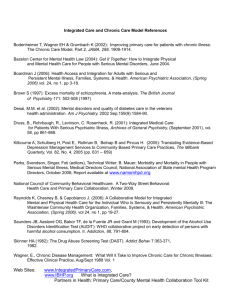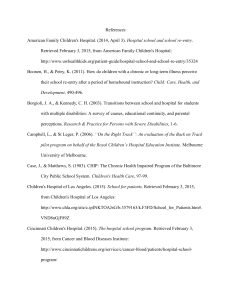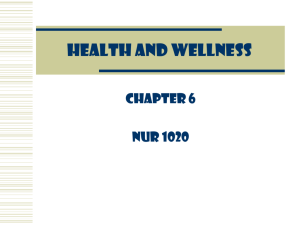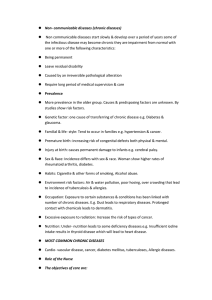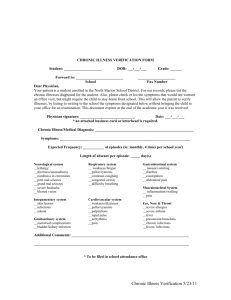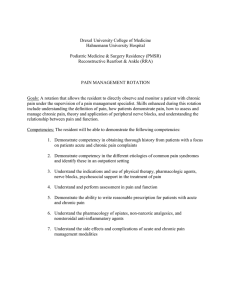Chronic Disease Management: What Will It Take To Improve Care for Chronic Illness?
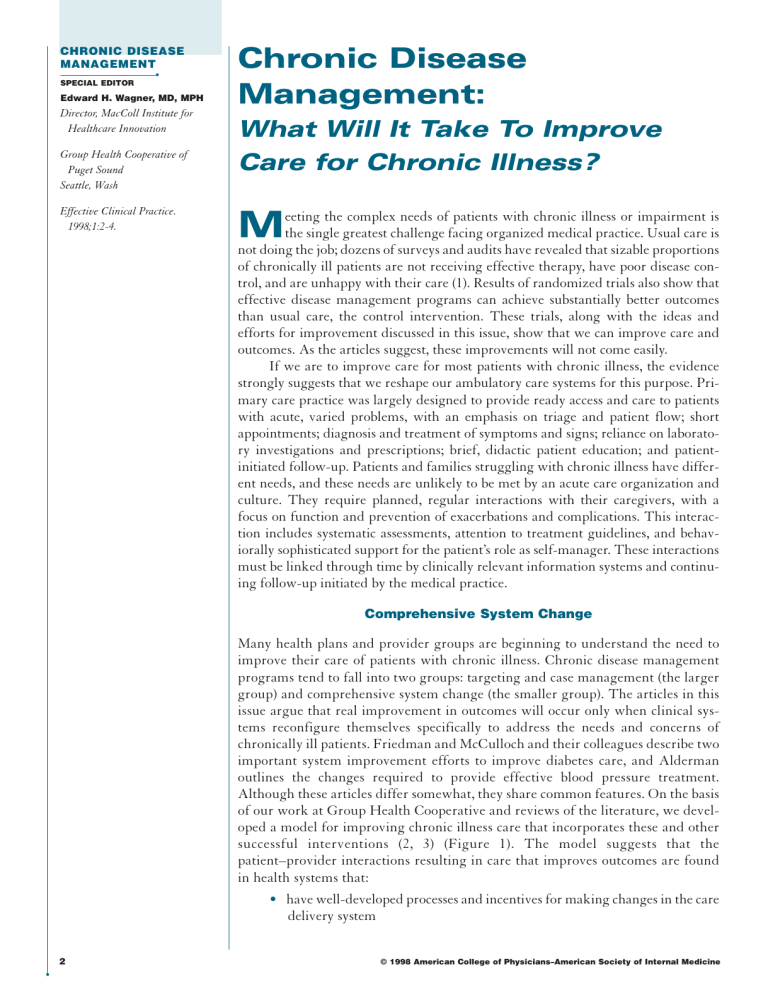
•
2
CHRONIC DISEASE
MANAGEMENT
•
SPECIAL EDITOR
Edward H. Wagner, MD, MPH
Director, MacColl Institute for
Healthcare Innovation
Group Health Cooperative of
Puget Sound
Seattle, Wash
Effective Clinical Practice.
1998;1:2-4.
Chronic Disease
Management:
What Will It Take To Improve
Care for Chronic Illness?
M eeting the complex needs of patients with chronic illness or impairment is the single greatest challenge facing organized medical practice. Usual care is not doing the job; dozens of surveys and audits have revealed that sizable proportions of chronically ill patients are not receiving effective therapy, have poor disease control, and are unhappy with their care (1). Results of randomized trials also show that effective disease management programs can achieve substantially better outcomes than usual care, the control intervention. These trials, along with the ideas and efforts for improvement discussed in this issue, show that we can improve care and outcomes. As the articles suggest, these improvements will not come easily.
If we are to improve care for most patients with chronic illness, the evidence strongly suggests that we reshape our ambulatory care systems for this purpose. Primary care practice was largely designed to provide ready access and care to patients with acute, varied problems, with an emphasis on triage and patient flow; short appointments; diagnosis and treatment of symptoms and signs; reliance on laboratory investigations and prescriptions; brief, didactic patient education; and patientinitiated follow-up. Patients and families struggling with chronic illness have different needs, and these needs are unlikely to be met by an acute care organization and culture. They require planned, regular interactions with their caregivers, with a focus on function and prevention of exacerbations and complications. This interaction includes systematic assessments, attention to treatment guidelines, and behaviorally sophisticated support for the patient’s role as self-manager. These interactions must be linked through time by clinically relevant information systems and continuing follow-up initiated by the medical practice.
Comprehensive System Change
Many health plans and provider groups are beginning to understand the need to improve their care of patients with chronic illness. Chronic disease management programs tend to fall into two groups: targeting and case management (the larger group) and comprehensive system change (the smaller group). The articles in this issue argue that real improvement in outcomes will occur only when clinical systems reconfigure themselves specifically to address the needs and concerns of chronically ill patients. Friedman and McCulloch and their colleagues describe two important system improvement efforts to improve diabetes care, and Alderman outlines the changes required to provide effective blood pressure treatment.
Although these articles differ somewhat, they share common features. On the basis of our work at Group Health Cooperative and reviews of the literature, we developed a model for improving chronic illness care that incorporates these and other successful interventions (2, 3) (Figure 1). The model suggests that the patient–provider interactions resulting in care that improves outcomes are found in health systems that:
• have well-developed processes and incentives for making changes in the care delivery system
© 1998 American College of Physicians–American Society of Internal Medicine
• assure behaviorally sophisticated self-management support that gives priority to increasing patients’ confidence and skills so that they can be the ultimate manager of their illness (4)
• reorganize team function and practice systems
(e.g., appointments and follow-up) to meet the needs of chronically ill patients
• develop and implement evidence-based guidelines and support those guidelines through provider education, reminders, and increased interaction between generalists and specialists
• enhance information systems to facilitate the development of disease registries, tracking systems, and reminders and to give feedback on performance.
Because of the heavily preventive nature of highquality care for chronic illness, the system changes for this care shown in Figure 1 are similar to the 10 processes that improve prevention performance, as discussed by
Solberg and colleagues in this issue.
The model assumes that the locus of care remains with the personal physician, supported by an integrated (and perhaps expanded) practice team. Targeting and case management activities, sometimes known as carve-ins or carve-outs , do not always make this assumption. In fact, many seem to operate on four major premises:
1. Reduction in the cost of chronic illness is the major goal and is assumed to be associated with improvements in health.
2. The best way to achieve cost reduction is to focus on the highest-cost patients in the chronically ill population.
3. Primary care is not up to the task of chronic illness care.
4. Patients will do better if their chronic disease management is largely removed from primary care and is delegated to a case manager.
These premises need to be examined and confirmed rigorously and quickly, because disease management programs based on these conceptual underpinnings are becoming the accepted standard. Regardless of whether these premises are true, such programs have potentially serious adverse consequences and have not received sufficient attention.
Community
Resources and Policies
Self-management
Support
Health System
Organization of Health Care
Decision
Support
Delivery
System
Design
Clinical
Information
Systems
Informed,
Activated
Patient
Productive
Interactions
Prepared,
Proactive
Practice Team
Functional and Clinical Outcomes
FIGURE 1.
Model for improvement of chronic illness care.
Outcomes of Care Improvement
Although improved chronic illness care can save money by reducing exacerbations and institutionalization, emphasizing cost reduction rather than quality improvement may be dangerous if it reduces access to effective services. This may be the case with several chronic illnesses. The best approach to cost savings is to improve health status: that is, to ensure access to services that are proven to improve outcomes. This may require an initially higher outlay of funds. Stroke care may illustrate this point: Evidence is mounting that admission to special stroke inpatient units (5, 6) followed by intensive rehabilitation results in much better outcomes. Such approaches seem to run counter to many case management approaches, which encourage brief hospitalizations and lower-intensity follow-up care (7). If case managers were clinically sophisticated advocates for evidence-based care, outcomes might improve. However, a recent review of case management programs (8) suggests that most case managers do little more than review utilization.
Targeting is the other pillar of modern disease management; this approach correctly assumes that a small percentage of the population accounts for most health care costs. But does it make sense to concentrate on a small subset of a chronically ill population? It may not, for two reasons. First, health status changes frequently among older and chronically ill adults, so that today’s high utilizers may not be next year’s. For example, we have shown that a complex risk equation involving past utilization and current health status accounts for less than 70% of the variation in future hospitalization rates among elderly persons (9). Thus,
Effective Clinical Practice ■ August/September 1998 Volume 1 Number 1 3
•
•
4 most targeting schemes exclude a substantial percentage of persons at risk. Second, and more important, almost all patients with major chronic illnesses, such as asthma, AIDS, congestive heart failure, chronic obstructive pulmonary disease, depression, diabetes, and epilepsy, benefit from periodic assessment of clinical and psychosocial status, effective medical therapy, greater confidence and skills in self-management, and sustained follow-up. Thus, improved chronic disease management should benefit most of the population with a given chronic illness. As several articles in this issue suggest, risk stratification may make good sense if it is accompanied by efforts to improve care for each stratum of health care utilizers. Systems that carve out the highest-utilizing patients for case management without making efforts to improve care for the remainder seem only to be interested in reducing cost, regardless of their motivation.
The Primary Care Team
How does separating chronic illness care from primary care affect the patient and the primary care team?
Evidence to answer this question is scanty and urgently needed. The paper by O’Connor and colleagues in this issue provides some evidence of the importance of professional advice in patient decisions about an important chronic disease intervention—aspirin treatment. But, some very successful chronic disease management programs seem to have involved the patient’s primary care team only tangentially (10, 11). However, these programs included only a few hundred patients collected in a community or a hospital; therefore, their impact on any particular primary care practice was probably minimal. If many chronically ill patients in a practice are cared for by a separate system, how does this affect the practice’s ability to care for the rest of its patients with chronic illness and the intellectual and emotional rewards of practice? If trends continue, primary care practice will increasingly resemble nonurgent emergency care, with chronic illness care left to case managers, hospital care to hospitalists, and preventive care to centralized systems.
Our primary care system is increasingly being absorbed by the care of older and chronically ill persons.
It will either change accordingly or risk being pulled apart because it cannot do the job well enough.
Everyone may suffer as a consequence.
References
1. Wagner EH. Managed care and chronic illness: health services research needs. Health Serv Res. 1997;32:702-14.
2. Wagner EH, Austin BT, Von Korff M. Improving outcomes in chronic illness. Managed Care Quarterly. 1996;4:12-25.
3. Wagner EH, Austin BT, Von Korff M. Organizing care for patients with chronic illness. Milbank Q. 1996;74:511-44.
4. Von Korff M, Gruman J, Schaefer J, Curry SJ, Wagner EH.
Collaborative management of chronic illness. Ann Intern Med.
1997;127:1097-102.
5. Indredavik B, Slørdahl SA, Bakke F, Rokseth R, Håheim LL.
Stroke unit treatment. Long-term effects. Stroke. 1997;28:1861-66.
6. Ronning OM, Guldvog B. Stroke units versus general medical wards, I: twelve- and eighteen-month survival: a randomized, controlled trial. Stroke. 1998;29:58-62.
7. Retchin SM, Brown RS, Yeh SC, Chu D, Moreno L.
Outcomes of stroke patients in Medicare fee for service and managed care. JAMA. 1997;278:119-24.
8. Pacala JT, Boult C, Hepburn K, et al. Case management of older adults in health maintenance organizations. J Am Geriatr
Soc. 1995;43:538-42.
9. Coleman EA, Wagner EH, Grothaus LC, Hecht J, Savarino J,
Buchner DM. Predicting hospitalization and functional decline in older health plan enrollees: are administrative data as accurate as self-report? J Am Geriatr Soc. 1998;46:419-25.
10. Rich MW, Beckham V, Wittenberg C, Leven CL, Freedland
KE, Carney RM. A multidisciplinary intervention to prevent the readmission of elderly patients with congestive heart failure. N
Engl J Med. 1995;333:1190-95.
11. Stuck AE, Aronow HU, Steiner A, et al. A trial of annual in-home comprehensive geriatric assessments for elderly people living in the community. N Engl J Med. 1995;333:1184-89.
Correspondence
Edward H. Wagner, MD, MPH, Director, MacColl Institute for
Healthcare Innovation, Center for Health Studies, Group Health
Cooperative of Puget Sound, 1730 Minor Avenue, Suite 1290,
Seattle, WA 98101; e-mail: wagner.e@ghc.org.
This paper is available at ecp.acponline.org.
Effective Clinical Practice ■ August/September 1998 Volume 1 Number 1
